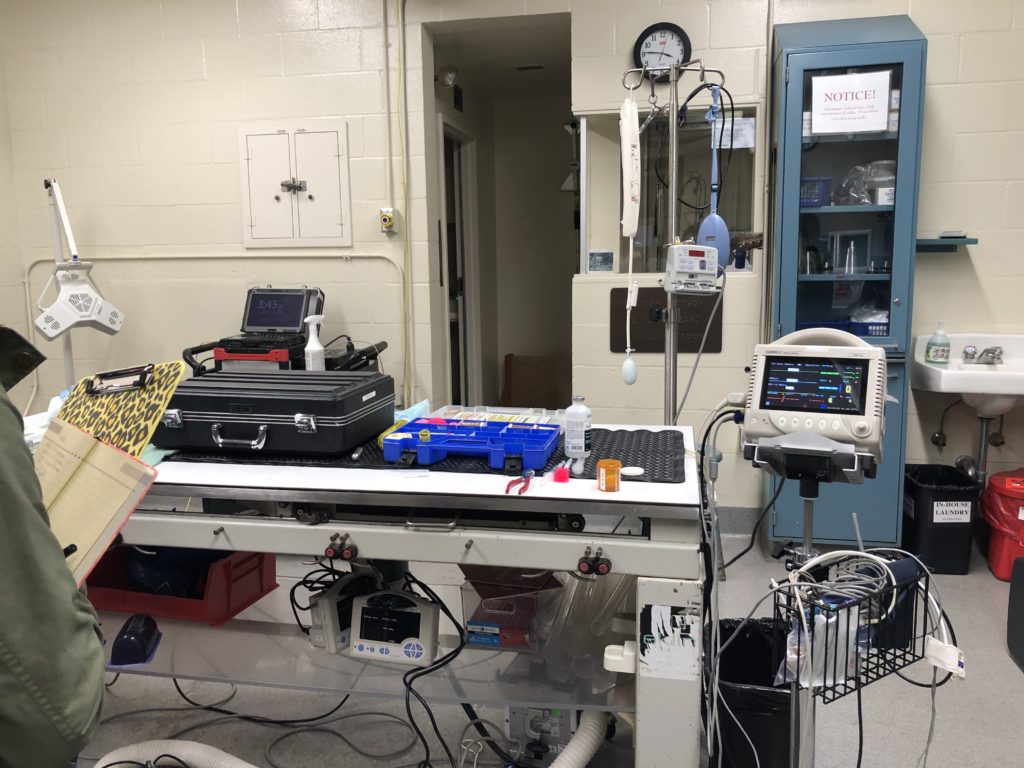
Zoo InternQuest is a seven-week career exploration program for San Diego County high school juniors and seniors. Students have the unique opportunity to meet professionals working for the San Diego Zoo, Safari Park, and Institute for Conservation Research, learn about their jobs, and then blog about their experience online. Follow their adventures here on the Zoo’s website!

When imagining a veterinary clinic, you would most likely see a place filled with cats, dogs, and other household pets awaiting treatment. Now imagine such a place where in a single day, animals ranging from zebras to lizards are all treated. Interesting right? Well, for Dr. Megan Sutherland-Smith, Director of Veterinary Services at the San Diego Zoo, that is just a normal day at work. This week in Zoo InternQuest, we got the opportunity to learn the in’s and out’s of the hospital, as told by Dr. Sutherland Smith.
Upon entering the hospital, Dr.Sutherland spoke to us about one of the first treatments animals usually experience at the hospital: anesthesia. It is important to note that most of the animals that go to the hospital are not domesticated, but wild animals, so using anesthesia is the safest and least stressful way of putting an large animal that is difficult to control in a suitable state for treatment. Due to the range of unique animals that live at the Zoo, there are multiple methods for treating them with anesthesia. One such method, darting, uses an air system to inject darts into larger animals, which then receive anesthesia through a pressurized system in the dart. Other methods of using anesthesia at the hospital are not too different from methods used on humans, such as using gas, an IV, or a hand injection. However, the size of equipment used to administer anesthesia varies from a gas mask the size of a golf ball, to one the size of a basketball.
There are many treatments administered at the hospital, such as routine check-ups, exams for leaving or entering the collection and emergencies, and also for dystocias, which are difficult births. Most of these involve giving an animal a CT scan, or radiograph(informally known as an X-Ray), in order to help vets better analyze an animal from an internal point of view, which leads to a better-informed diagnosis. Once these images are taken, they are looked at by veterinarians, in order to figure out what is wrong with an animal. Along with showing us some example radiographs, Dr. Sutherland-Smith also introduced us to Dr. Ben Nevitt, who showed us some CT scans which were taken that day. Dr. Nevitt showed us that unlike radiographs, MRI scans can show a 3-Dimensional view of an animal’s interior which can be seen from different angles. This allows doctors to better analyze exactly what is happening inside an animal, as they can have a better view of the problem when compared to that of a radiograph.
Once an animal’s ailment has been identified, they may need to go into surgery. Similar to human surgery, it is important to keep an animal safely asleep. One important tool used to ensure an animal’s safety is an endotracheal tube, which keeps an animal’s airway open throughout surgery. Other tools used to analyze the status of an animal are pulse oximeters, which report the heartbeat of an animal, and also EKG’s, which are multimodal monitors, which continuously monitor the animal’s heart rate and blood oxygen levels. It is important to know that all of these methods of treatment are taken directly from human medicine, so as human medicine advances, as does veterinary medicine.
Overall, Dr. Sutherland-Smith and Dr. Nevitt describe themselves as generalists, who know a lot about a lot of different things. This is important because it would be impossible to know all the in-depth details about every animal in the Zoo, so when it comes to emergency situation, generalists like them are able to make a quick call which can determine whether or not an animal survives. Without zoo veterinarians like Dr. Sutherland-Smith and Dr. Nevitt, maintaining the health of every Zoo animal would be an impossible feat.
Evelyn, Real World Team
Week Two, Winter Session 2019




